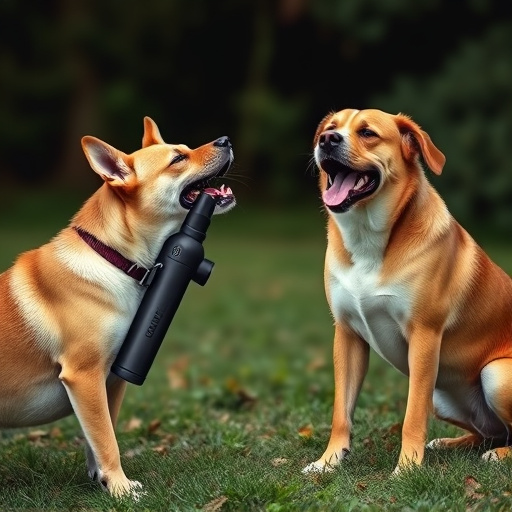Dog spray (mace canine spray) is a non-lethal self-defense tool that temporarily incapacitates attacking dogs using capsaicin, an irritant in chili peppers. It has a specific pattern width designed to disrupt the dog's vision and breathing, enabling escape or help. Narrower patterns offer precision targeting while broader ones provide a safety net. Effective aiming at sensitive areas like the face and eyes is crucial. Post-exposure care involves rinsing affected areas with warm water, and understanding legal regulations on mace use to avoid penalties and protect others.
“Staying safe during encounters with aggressive dogs is paramount. This comprehensive guide explores self-defense against dog spray, a powerful tool for personal protection. We delve into ‘Mace Canine Spray,’ uncovering its mechanics and effectiveness. From understanding the spray’s reach (Mace Canine Spray Pattern Width) to mastering application techniques, this article equips you with knowledge. Learn about post-exposure care and legal aspects, ensuring responsible use. Equip yourself with the right tools and tactics for dog spray self-defense.”
- Understanding Dog Spray: What It Is and How It Works
- Choosing the Right Self-Defense Mace for Canine Spray
- Effective Use Techniques: Aiming and Spray Pattern Width
- Post-Exposure Care and Legal Considerations After Using Dog Spray
Understanding Dog Spray: What It Is and How It Works
Dog spray, often referred to as mace canine spray, is a non-lethal self-defense tool designed to incapacitate an attacking dog temporarily. It works by targeting the dog’s eyes and respiratory system. When deployed, the spray creates a fog or stream with a specific pattern width that disrupts the animal’s ability to see and breathe effectively. This disruption enables the user to escape or subdue the dog until help arrives.
The mechanism behind dog spray is based on capsaicin, the active ingredient found in chili peppers. This chemical irritates the dog’s mucous membranes, causing them to temporarily close off, thereby reducing visibility and making it hard for the animal to inhale. The effect is rapid yet usually wears off after a few minutes, allowing the dog to recover without lasting harm. Understanding these principles can help individuals respond appropriately when facing an aggressive canine.
Choosing the Right Self-Defense Mace for Canine Spray
When selecting self-defense mace for canine spray, consider the pattern width and its impact on effectiveness. A narrower spray pattern may be more precise, allowing you to target specific areas, which can be beneficial in controlling an aggressive dog. However, a broader pattern offers a safety net, ensuring that even if you miss, some of the spray will still reach the canine assailant.
Look for mace designed specifically for dog interactions, as these formulations are less likely to irritate your eyes and skin compared to standard pepper spray. The mace canine spray should also have a good range—typically 2-3 meters (6-10 feet)—to give you ample space to retreat while still neutralizing the threat. Always check local regulations regarding self-defense tools, ensuring that mace is legal and permitted for personal protection in your area.
Effective Use Techniques: Aiming and Spray Pattern Width
When using mace canine spray, understanding effective aiming techniques is key. The goal isn’t to blind the dog but to disrupt its behavior and gain time to escape or call for help. Aim for the face and eyes, as irritants targeted at these areas can cause temporary blindness and disorientation in dogs. Practice your aim by targeting a wall or a friend’s shoulder— ensuring you can accurately hit close-range targets.
Spray pattern width is another crucial aspect. Mace sprays create a cone-shaped blast of irritants, with the widest part covering an area roughly 3 to 4 feet wide at eye level. This means you should stand at a safe distance, usually around 10 to 15 feet away from the dog, to ensure maximum effectiveness and minimize collateral damage. Holding the can at a slight angle towards the target area will help control the spray pattern width.
Post-Exposure Care and Legal Considerations After Using Dog Spray
After using dog spray, proper post-exposure care is essential to ensure your safety and well-being. If you’ve been targeted by a dog, rinse the affected area with warm water as soon as possible. Remove any clothing or accessories that came into contact with the spray, and wash them separately in hot water. It’s crucial to avoid rubbing the skin, as it can spread the irritant. Calming down is also vital; stay calm and monitor your breathing for any discomfort or difficulty. If symptoms persist or worsen, seek medical attention immediately.
Legally, understanding the regulations around dog spray usage is imperative. Each jurisdiction has specific laws governing the use of canine spray or mace. Be aware of the permitted pattern width and distance for application to avoid potential legal repercussions. Always carry identification when using such devices in public spaces to comply with local ordinances. Remember that responsible use includes ensuring the spray doesn’t reach bystanders, pets, or vulnerable individuals, as this could lead to fines or civil lawsuits.
Knowing how to defend yourself against dog spray is invaluable, as it can be a dangerous and unpredictable weapon. By understanding the nature of canine spray, selecting the right mace designed for dog spray (including considering factors like brand reputation and active ingredient strength), learning effective use techniques including aiming and spray pattern width, and being aware of post-exposure care and legal considerations, you’ll be better prepared to protect yourself in encounters with aggressive dogs. Remember, always prioritize safety and follow local laws when carrying and using self-defense mace.
